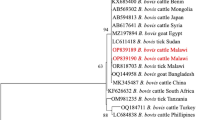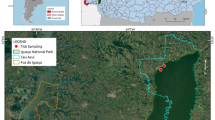Abstract
The Italian hare (Lepus corsicanus) is an endangered species whose natural populations have decreased in recent years. This study’s objective was to identify ticks infesting hares and their habitats in a wildlife reserve in southern Italy. In June 2009, ticks were collected by dragging in three transects set in a meadow habitat within an enclosure inhabited by hares and in three similar transects outside this enclosure. Fifty-five ticks were collected by dragging, being 54 inside and 1 outside the enclosure. Ticks were identified as Hyalomma marginatum (34 males, 17 females), Dermacentor marginatus (2 males, 1 female), and Rhipicephalus bursa (1 female). In September 2009, ticks were collected from 17 Italian hares and identified as Ixodes ricinus (2 larvae, 45 nymphs, 35 males, 37 females), Rhipicephalus turanicus (2 males, 1 nymph), and Hyalomma sp. (165 nymphs). PCR amplification and sequencing of a partial region of the 12S rDNA gene of Hyalomma nymphs allowed their identification as H. marginatum. This study suggests that host presence is a factor determining the level of environmental tick infestation as well as the free-living tick species in the study area and that Italian hares are hosts for I. ricinus and H. marginatum. Studies to assess whether these ticks could limit the survival and fitness of Italian hares and affect their conservation status are needed. Moreover, it is necessary to investigate whether these ticks are infected with pathogens of medical and veterinary concern.

Similar content being viewed by others
References
Angelici FM, Luiselli L (2001) Distribution and status of the apennine hare Lepus corsicanus in continental Italy and Sicily. Oryx 35:245–249
Apanaskevich DA, Horak IG (2008) The genus Hyalomma Koch, 1844: V. Re- evaluation of the taxonomic rank of taxa comprising the H. (Euhyalomma) marginatum Koch complex of species (Acari: Ixodidae) with redescription of all parasitic stages and notes on biology. Int J Acarol 34:13–42
Beati L, Keirans JE (2001) Analysis of the systematic relationships among ticks of the genera Rhipicephalus and Boophilus (Acari: Ixodidae) based on mitochondrial 12S ribosomal DNA gene sequences and morphological characters. J Parasitol 87:32–48
Bernasconi MV, Casati S, Péter O, Piffaretti JC (2002) Rhipicephalus ticks infected with Rickettsia and Coxiella in Southern Switzerland (Canton Ticino). Infect Genet Evol 2:111–120
Bush AO, Lafferty KD, Lotz JM, Shostak AW (1997) Parasitology meets ecology on its own terms: Margolis et al.revisited. J Parasitol 83:575–583
Cinco M, Barbone F, Grazia Ciufolini M, Mascioli M, Anguero Rosenfeld M, Stefanel P, Luzzati R (2004) Seroprevalence of tick-borne infections in forestry rangers from northeastern Italy. Clin Microbiol Infect 10:1056–1061
Epis S, Sassera D, Beninati T, Lo N, Beati L, Piesman J, Rinaldi L, McCoy KD, Torina A, Sacchi L, Clementi E, Genchi M, Magnino S, Bandi C (2008) Midichloria mitochondrii is widespread in hard ticks (Ixodidae) and resides in the mitochondria of phylogenetically diverse species. Parasitology 135:485–494
Floris R, Yurtman AN, Margoni EF, Mignozzi K, Boemo B, Altobelli A, Cinco M (2008) Detection and identification of Rickettsia species in the northeast of Italy. Vector Borne Zoonotic Dis 8:777–782
Horak IG, Fourie LJ (1991) Parasites of domestic and wild animals in South Africa XXIX. Ixodid ticks on hares in the Cape Province and on hares and red rock rabbits in the Orange Free State. Onderstepoort J Vet Res 58:261–270
Horak IG, MacIvor KM (1987) The scrub hare, a reliable indicator of the presence of Hyalomma ticks in the Cape Province. J S Afr Vet Assoc 58:15–19
Horak IG, Spickett AM, Braack LE, Penzhorn BL (1993) Parasites of domestic and wild animals in South Africa.XXXII. Ixodid ticks on scrub hares in the Transvaal Onderstepoort. J Vet Res 60:163–174
IUCN (2009) IUCN Red list of threatened species. Version 2009.2. Accessed at: www.iucnredlist.org. Accessed 12 Feb. 2010
Manilla G (1998) Fauna d’Italia, Acari-Ixodida. Edizioni Calderini, Bologna
Mantelli B, Pecchioli E, Hauffe HC, Rosà R, Rizzoli A (2006) Prevalence of Borrelia burgdorferi s.l. and Anaplasma phagocytophilum in the wood tick Ixodes ricinus in the Province of Trento, Italy. Eur J Clin Microbiol Infect Dis 25:737–739
Mura A, Masala G, Tola S, Satta G, Fois F, Piras P, Rolain JM, Raoult D, Parola P (2008) First direct detection of rickettsial pathogens and a new rickettsia, ‘Candidatus Rickettsia barbariae’, in ticks from Sardinia, Italy. Clin Microbiol Infect 14:1028–1033
Otranto D, Dantas-Torres F, Mallia E, DiGeronimo PM, Brianti E, Testini G, Traversa D, Lia RP (2009) Thelazia callipaeda (Spirurida, Thelaziidae) in wild animals: report of new host species and ecological implications. Vet Parasitol 166:262–267
Pierpaoli M, Riga F, Trocchi V, Randi E (1999) Species distinction and evolutionary relationships of the Italian hare (Lepus corsicanus) as described by mitochondrial DNA sequencing. Mol Ecol 8:1805–1817
Pittalis S, Meschi S, Castilletti MC, Di Caro A, Puro V (2009) Febbre emorragica virale Crimea-Congo: un pericolo alle porte. Infez Med 17:133–140
Rechav Y (1986) Seasonal activity and hosts of the vectors of Crimean-Congo haemorrhagic fever in South Africa. S Afr Med J 69:364–368
Swanepoel R, Struthers JK, Shepherd AJ, McGillivray GM, Nel MJ, Jupp PG (1983) Crimean-congo hemorrhagic fever in South Africa. Am J Trop Med Hyg 32:1407–1415
Szabó MP, Mangold AJ, João CF, Bechara GH, Guglielmone AA (2005) Biological and DNA evidence of two dissimilar populations of the Rhipicephalus sanguineus tick group (Acari: Ixodidae) in South America. Vet Parasitol 130:131–140
Tälleklint L, Jaenson TG (1993) Maintenance by hares of European Borrelia burgdorferi in ecosystems without rodents. J Med Entomol 30:273–276
Tälleklint L, Jaenson TG (1997) Infestation of mammals by Ixodes ricinus ticks (Acari: Ixodidae) in south-central Sweden. Exp Appl Acarol 21:755–771
Thompson JD, Gibson TJ, Plewniak F, Jeanmougin F, Higgins DG (1997) The CLUSTAL_X windows interface: flexible strategies for multiple sequence alignment aided by quality analysis tools. Nucleic Acids Res 25:4876–4882
Tomassone L, Camicas JL, De Meneghi D, Di Giulio A, Uilenberg G (2005) A note on Hyalomma nitidum, its distribution and its hosts. Exp Appl Acarol 35:341–355
Walker JB, Keirans JE, Horak IG (2000) The genus Rhipicephalus (Acari, Ixodidae): a guide to the brown ticks of the world. Cambridge University Press, Cambridge
Acknowledgments
This work has been supported by the Fondazione Cassa di Risparmio di Puglia and by the Parco Regionale Gallipoli Cognato Piccole Dolomiti Lucane.
Author information
Authors and Affiliations
Corresponding authors
Rights and permissions
About this article
Cite this article
Dantas-Torres, F., Testini, G., DiGeronimo, P.M. et al. Ticks infesting the endangered Italian hare (Lepus corsicanus) and their habitat in an ecological park in southern Italy. Exp Appl Acarol 53, 95–102 (2011). https://doi.org/10.1007/s10493-010-9387-3
Received:
Accepted:
Published:
Issue Date:
DOI: https://doi.org/10.1007/s10493-010-9387-3




